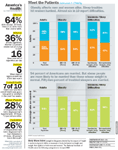- Sustainability
- DE&I
- Pandemic
- Finance
- Legal
- Technology
- Regulatory
- Global
- Pricing
- Strategy
- R&D/Clinical Trials
- Opinion
- Executive Roundtable
- Sales & Marketing
- Executive Profiles
- Leadership
- Market Access
- Patient Engagement
- Supply Chain
- Industry Trends
Meet the Patients
Pharmaceutical Executive
Pharma's ultimate customers are overweight and can't sleep. Ever wonder what they say about that? The National Health and Wellness Survey asked.
Doctors aren't the only ones who decide if a patient gets a particular drug. Third-party payers have a say and, increasingly, so do patients. For nearly a decade, pharma companies have been talking directly to the people who ingest their products. But the patients aren't always talking back. When the 2005 National Health and Wellness Survey asked patients about their health, the results were astonishing—particularly when it comes to insomnia and obesity.

More than 77 million Americans are obese, and 66 million more are overweight. Nationwide, more than 95 million people report insomnia or difficulty sleeping. Women have more trouble sleeping than men, but men and women are equally likely to be severely overweight. Married adults tend to obesity more than single people, while lower-income Americans suffer most often from both insomnia and obesity.

Body Mass Index (weight in kilograms divided by the square of height in meters) (kg/m2) BMI is a measure of body fat based on height and weight that applies to both men and women. The National Institute of Health uses the following categories to interpret BMI.

About the Data In one of the most comprehensive online annual surveys in the world, 41,000 Americans and 36,000 Europeans fill out detailed questionnaires about their diagnosed and undiagnosed conditions in 75 therapeutic areas. The data here are drawn from American respondents in 2005, and are weighted by gender, age, race/ethnicity, and education. Staff epidemiologists projected the sample onto the total US population to create a representative portrait of the American market. Data were validated through comparisons to the US census and the National Health Interview Survey.

Healthcare Marketing Strategies for Reaching Diverse Audiences
May 14th 2024Amanda Powers-Han, Chief Marketing Officer, Greater Than One, and Pharmaceutical Executive Editorial Advisory Board member, discusses how improved DE&I in healthcare marketing strategies can not only reach diverse audiences more effectively but also contribute to improved patient care outcomes, challenges faced in crafting culturally sensitive messages, and much more.
